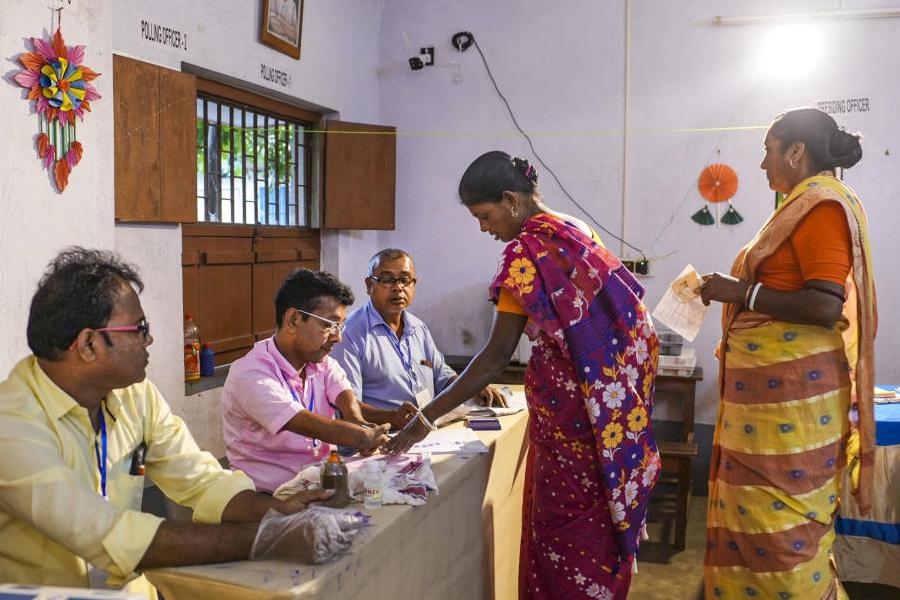
Photo: Jagan Negi
Have you ever gazed longingly at hot fluffy bhaturas accompanied by lip-smacking spicy chholey (chickpeas) and then turned them down as being too weight-gainingly sinful?
Hang on a sec and give that batura a closer look. Has it been made using one of the New Age types of speciality flours that have hit the market? Can you reach for that plate of chholey-batura without adding on too many calories or sending the delicate cholesterol meter in your system shooting upwards?
That’s the promise on offer from scores of new types of specialty flours hitting the market. Gym addicts can stock up on fitness atta and there’s slimming atta for those of us who want to avoid piling on the avoirdupois. There’s also Maida Replacer flour or even sprouted lentils flour which offers extra protein and a slightly different taste.
.jpg)

“Everyone has become so health conscious that they are moving towards gluten-free and healthier options,” says Ishi Khosla, a leading nutritionist, who also owns a company called Whole Foods that offers a range of high
nutrition food products and healthier types of flour. Whole Foods offers 18 types of flours including 11
gluten-free speciality varieties like 9 Grain Atta to High Fibre Atta and an even more exotic Lean flour.
Cut to Mumbai, where Jiwa, a Mumbai-based company that has been making flour for the last 50 years has now moved into turning out 10 different types of speciality flour with ingredients like sand-puffed Bengal gram, toasted oats and wheat germ.
The company goes an extra mile to make sure that these different varieties appeal to your taste buds. So, its Slimming Atta, for example, contains natural spinach powder that helps curb hunger, manage weight and even speed up your metabolism. Or, take a look at the Thepla Atta that uses hand-pounded traditional Gujarati spices to make it tastier. “We use the best available wheat variety called sharbati,” says Raghav Gupta, the brand’s founder, who has a sprawling facility on the outskirts of Mumbai.
If you are a fitness freak, you can try Jiwa’s fitness atta that’s loaded with protein-rich quinoa, amaranth, chickpeas and toasted wheatgerm.
.jpg)
Photos: Jagan Negi
.jpg)
These new types of flour are aimed at everyone from the super-fit who want to stay that way, to others suffering from a range of lifestyle diseases like diabetes, or blood pressure, or even other patients with special needs.
One sure sign that speciality flours have gone mainstream is that Foodhall, a super-premium lifestyle store that’s a part of Kishore Biyani’s Future Group, now stocks its own speciality flour brand called Traditions that offers 15 new and innovative varieties.
“These flours have become so popular that most of my clients have already started using several types and only come to me to find out if they have been doing it right!” says Gargi Sharma, a Delhi-based nutritionist and the head of the weight-loss programme department at Aayna Clinic.
Take a look at Khosla’s 9 Grain Atta that’s aimed at everyone from the health-conscious to weight-watchers and diabetics to people with other lifestyle diseases. The company says that it’s “heart-friendly” and put together nine types of grain, including barley, Bengal gram, jowar, bajra and wheat bran. Says Khosla: “It’s best to add a variety of grains in your diet instead of sticking with a single grain. So, a specialty flour such as our 9 Grain Atta lowers your glycemic index to give you the metabolic edge and increases nutrients intake in your diet.”
Her High Fibre Atta that’s made using very different ingredients including black gram, soya, arrowroot, psyllium husk and xanthan gum is also a popular food additive. Whole Foods says most people will need to eat smaller quantities of chapatis made with High Fibre Atta “due to its filling attribute”.
Even Biyani’s Traditions offers everything from quinoa flour to cashew almond and sprouted peas flour.
.jpg)
.jpg)
Similarly, Sanjay Tiwari’s Wellness Q.E.D with its Zero G brand offers products like Triple Grains flour for the weight-
conscious and those who want to up their fitness quotient while staying clear of wheat. This is a blend of amaranth flour, sorghum (jowar) flour, and finger millets (ragi) flour
Tiwari’s Zero G has burgeoned in the last decade making special food for hospitals and also for people suffering from illnesses like coeliac disease and even autism. “Our Hulled Buckwheat flour is very good for people with autism,” says Tiwari, whose company makes eight types of flour. It should be mentioned, though, that doctors are divided about whether a gluten-free diet affects autism.
Others, too, have products aimed specifically at lifestyle diseases, like Jiwa’s Blood Pressure Care Atta which has a mix of whole wheat, chickpea and curry leaves that are designed to reduce the risk of coronary and vascular diseases and kidney problems.
Khosla has the Special Glycaemic Atta, one of her highest selling products, which has special ingredients for diabetics such as flaxseeds, bitter gourd and kalonji. Khosla recommends upping the taste quotient by adding items like chopped dhaniya, onions and boiled veggies to create a delicious and healthy meal.
The ingredients that go into speciality flour are a testimony to the new trends in popular foods around the globe. Take quinoa, for instance, which was originally from South America and which is now even being grown in Madhya Pradesh. It is rich in proteins and dietary fibre and also B vitamins, which is why it has grown in popularity around the globe.
Then, there’s amaranth, which is grown in South America and also the Indian subcontinent. This mildly sweet-tasting, protein-rich and gluten-free grain is a good source of protein, vitamins and minerals and has cholesterol-lowering properties. Aayna’s Sharma suggests mixing amaranth with rice flour to keep the dough soft.
Swasti Aggarwal, corporate chef with Foodhall, is particularly fond of amaranth flour, which she says, has gained in popularity because of its versatility. “One can do herb and garlic amaranth crackers or make rolls or wraps. You can also try masala puri and thalipeeth, a healthy Maharastrian pancake, or even a sheera with it,” she says.
At a different level, one company, Conscious Food, a Mumbai-based organic food brand, offers everything from speciality atta to a wide range of healthy snacks like khakra (a Gujarati snack), crackers, sticks, dippers, etc., made out of alternative healthful flours such as brown rice. The brand has a panel of nutritionists that oversees the nutritional value of these speciality flours. “One can make popular and exciting recipes like pita bread, pancakes, dosa, upma and porridge using these flours,” says Kingshuk Basu, the company’s CEO.

Photo: Jagan Negi
For Zero G’s Tiwari, one of his big winners is what’s called the Maida Replacer, a sorghum and tapioca based flour. “I get a lot of orders for this both from India and overseas,” says Tiwari, who has customers in the US, the UK and Canada. “You can never differentiate between a millet and a maida samosa. So you might as well eat healthy,” he adds.
The makers of healthier atta and the nutritionists insist that you can’t tell a regular wheat chapati from a gluten-free chapati because of its amazing rolling and puffing properties.
That’s where the role of a binding agent comes in. “It not only prevents the flour from breaking down but also helps to puff up the chapatis,” says Khosla, who uses naturally-occurring guar gum and xanthan gum in beans as the best substitute to gluten that gives a binding effect to the flour. “Besides, it also has many health benefits such as lowering cholesterol and sugar levels in the body,” she says.
Zero G, on the other hand, uses natural starches for binding. “Even if a gluten-free flour uses vegetable starch or potato starch that are not chemical-based in small quantities, they don’t pose any health hazard,” says Sharma.
Still, some first-time users do find the taste of items made with speciality flour different from wheat.
One good point is that there are different types of flour for different dishes. Aggarwal recommends using hazelnut flour in hot cereals or smoothies and which also gives pastries and cookies a distinctive taste.
“The new innovations like sprouted flour and other nut flours have boosted our sales,” says Jay Jhaveri, COO of Foodhall that sources its grains from around the world.
Of course, speciality flours are more expensive than run-of-the-mill atta. So, prices can vary from Rs 60 per kg to Rs 360 for 1.25kg and are easily available in major health food stores. You can also order them through their websites and major retail platforms.
Making life more complicated, is the fact that many of these flours have a shelf-life of only four to six months.
But that isn’t stopping India’s health-conscious, rising middle class who are determined to eat right and going for flour power.










